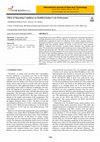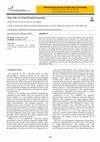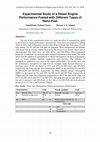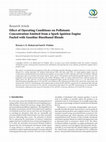Papers by Haroun Al-janabi
International Journal of Current Engineering and Technology, Jan 30, 2018
Flame speed is an important aspect of fuel combustion characteristics. It affects combustion syst... more Flame speed is an important aspect of fuel combustion characteristics. It affects combustion system design and performance. In this study, a laboratory experimental rig has been built to investigate the effect of equivalence ratio of gasoline-air mixture in a centrally ignited constant volume combustion chamber on flame speed at an initial pressure of 1bar and an initial temperature of 483 K using high speed flame photography technique. The results of the outwardly expanding spherical flame showed that the flame speed depends on both equivalence ratio and flame radius. It decreases slightly with the increase of flame radius and increases with the equivalence ratio until slightly larger than stiochiometric and then decreases. The flame speed reached 1.
Applied sciences, May 9, 2023
This article is an open access article distributed under the terms and conditions of the Creative... more This article is an open access article distributed under the terms and conditions of the Creative Commons Attribution (CC BY
Iraqi journal of mechanical and material engineering, 2009
World Academy of Science, Engineering and Technology, International Journal of Mechanical, Aerospace, Industrial, Mechatronic and Manufacturing Engineering, Apr 20, 2011
Experiments were carried out to evaluate the influence of the addition of hydrogen to the inlet a... more Experiments were carried out to evaluate the influence of the addition of hydrogen to the inlet air on the performance of a single cylinder direct injection diesel engine. Hydrogen was injected in the inlet manifold. The addition of hydrogen was done on energy replacement basis. It was found that the addition of hydrogen improves the combustion process due to superior combustion characteristics of hydrogen in comparison to conventional diesel fuels. It was also found that 10% energy replacement improves the engine thermal efficiency by about 40% and reduces the sfc by about 35% however the volumetric efficiency was reduced by about 35%.
Iraqi journal of mechanical and material engineering, 2009

Scholars' Press eBooks, Oct 27, 2016
The world is facing a two fold crises now, shortage of conventional energy sources and environmen... more The world is facing a two fold crises now, shortage of conventional energy sources and environmental pollution. A lot of research is work needed to find new clean and sustainable energy source. Solar energy is the most abundant source of energy which is clean and sustainable but the the conversion efficiency of this energy into a more useful form of energy like electrical energy is still very low, about 15%, in addition to its intermittent nature which needs energy storage system. Solar energy can be used to power absorption/adsorption system instead of electrical energy to produce cooling/refrigeration effect. The use of this technique helps to reduce electrical energy consumption, save money and reduce the production of greenhouse gases. This book explains the design steps and construction of a solar driven absorption/adsorption cooling/refrigeration system.

Al-Qadisiyah Journal for Engineering Sciences, 2015
In this study, a design and fabrication of intermittent solar absorption refrigeration unit was p... more In this study, a design and fabrication of intermittent solar absorption refrigeration unit was performed at Hillah city in Iraq)32.4 o , 44.4 o ). The absorption solar unit consists of parabolic trough concentrator (PTC) was used as solar rays mirror reflector with aperture area of 2 m 2 , carbon steel pipe inside a vacuum glass envelop with a diameter of 1.5 in as tubular receiver, condenser, storage tank, evaporator. The aqua ammonia solution) NH4OH)is used as working fluid with different concentration (25%, 30%, 35%, 40%). The validity and visibility of the unit were evaluated by measurements of pressures and temperatures at different parts of the unit during a year from May month 2014 to July month 2015. The maximum pressure and temperature is found to be 12 bar and 120 o C respectively. The coefficient of performance was in the range of 0.01-0.09.
Design Engineering, Nov 18, 2021

International Journal of Heat and Technology, Dec 31, 2022
The main challenge of using Kalina cycle system (KCS) is to make use of waste heat to produce ele... more The main challenge of using Kalina cycle system (KCS) is to make use of waste heat to produce electrical power or cooling effect. Thus reducing fossil fuel consumption and pollutants emission. This study is concerned with a theoretical performance analysis of different configures of Kalina cycle. Three configurations are studied which are a simple Kalina cycle and two modifications of the simple cycle (MKCS1) and (MKCS2). A binary fluid of ammonia and water (NH3-H2O) is used as the working fluid. The varying operating parameters include ammonia mass fraction at turbine inlet and maximum cycle pressure. The dryness fraction at separator inlet is assumed constant and equal 0.3 and the minimum cycle is also assumed constant at 3bar. The results show that the maximum thermal efficiency for KCS, MKCS1 and MKCS2 are 8.64%, 12.7% and 18.85% respectively at the same conditions maximum pressure (Pmax)=35bar, minimum pressure (Pmin)=3bar, dryness fraction (DF)=0.3, ammonia mass fraction (x)=0.85 and the temperature at turbine inlet is 160℃. The maximum exergy efficiency for KCS, MKCS1 and MKCS2 are 34.21%, 51.92% and 75.34% respectively at the conditions Pmax=40bar, x=0.85, DF=0.3 and Pmin=3bar. The maximum net output power for KCS is 0.21kW at Pmax=15bar and x=0.85, the maximum net output power for MKCS1 and MKCS2 0.28kW and 0.41kW respectively at Pmax=30bar and x=0.89. This is equivalent to a reduction in the diesel fuel consumption by about 9.1*10-5 kgf/kWelec. Also it reduction the pollution especially CO2 about 2.91*10-4 kgCO2/kWelec.

International Journal of Heat and Technology, Nov 30, 2022
Kalina cycle system (SKCS) is used for low temperature, intermediate temperature and high tempera... more Kalina cycle system (SKCS) is used for low temperature, intermediate temperature and high temperature heat recoveries. However, its efficiency is rather low. Therefore, a modification is suggested to improve its efficiency. In this work a computer program is developed to predict the energy-exergy performance of a modified Kalina Cycle System (MKCS) using aqua ammonia solution. It consists of heat recovery vapor generator (HRVG), condenser, heat exchanger, separator, turbine, throttling valve, absorber and pump. The modification is implemented by introducing a heat exchanger (HE) between the separator and expansion valve. This HE is used to reheat the work solution which comes from the pump by the high temperature hot weak solution which comes from the separator. The effect of many operating conditions such as dryness fraction (DF) at separator inlet, low pressure and ammonia (NH3) mass fraction with constant high pressure on cycle performance is studied. The results show that the modified cycle efficiency is higher than the simple cycle efficiency by about 33.6% while the net power by about 27.8%. The highest efficiency and highest net output power are 14.7% and 0.5641 kW respectively. The exergy efficiencies for modified Kalina and simple Kalina are 24.8% and 11.7% respectively.

International Journal of Heat and Technology, Nov 30, 2022
The process of fuel droplet evaporating is one of the most important factors that directly affect... more The process of fuel droplet evaporating is one of the most important factors that directly affect the efficiency of the combustion process. Therefore, the current study reviews previous studies that focused on the process of evaporation of a drop of fuel. The review is divided into points. The first part is concerned with modeling of the evaporation process under different initial condition and temperature of the droplet. The second part present the experimental studies concerned with measuring the evaporation time of the droplet, as well as the shape of the droplet during the evaporation process. Most of the studies related to this subject can be divided into three categories: The first category is the studies that are concerned with the process of heating the droplet and studying the evaporation time for different types of fuels or by adding nanomaterials to the fuel and studying their effect on the evaporation process. The second category is the studies concerned with the mechanics of droplet evaporation and the study of droplet shape. The third category is the studies that focus on studying the effect of initial conditions, such as temperature and pressure, as well as the concentration of gasses surrounding the drop and their types. There are other studies concerned with projecting the electric field onto the drop during the evaporation process and studying its effect.

Journal of University of Babylon for engineering sciences, Jul 1, 2018
The aim of this experimental work is to study the effect of nanoparticles added to diesel fuel on... more The aim of this experimental work is to study the effect of nanoparticles added to diesel fuel on engine performance characteristic. Nano fuels are prepared by adding Al2O3 or TiO2, both with particle size less than 45nm of diesel fuel. Four doses of each type namely (25, 50, 100 and 150) ppm are prepared. These nanoparticles are blended with diesel fuel in varying volume fraction by the means of an electric mixer and an ultrasonicator. The Nano fuels are (DF+Al2O3) and (DF+TiO2). Physicochemical properties of nano fuels are measured and compared with these of neat diesel. The study shows that the addition of nanoparticles to diesel fuel improves its physical properties such as cetane number, thermal conductivity and viscosity. The influence of nanoparticles addition is very clear on the engine performance. The results show that the performance parameters are improved for example, brake thermal efficiency is increased from 19.4% for diesel to 21% and 25% for DF+Al2O3 and DF+TiO2 respectively, the brake specific fuel consumption (BSFC) is decreased by 8% and 20% for DF+Al2O3 and DF+TiO2 respectively, the brake specific energy consumption (BSFC) is decreased by 8% and 20% for DF+Al2O3 and DF+TiO2 respectively at 25ppm and 75% load. The exhaust gas temperature is 382°C for pure diesel while it is 417°C for DF+Al2O3 and 353°C for DF+TiO2. The peak pressure for pure diesel is 62 bar and it increases with DF+Al2O3 to 66.2 bar as for DF+TiO2 the peak pressure decreases to 57.2 bar at full load and 150ppm.

IOP conference series, Feb 1, 2021
Making use of the superior thermal properties of nanofluids is now very common, especially with r... more Making use of the superior thermal properties of nanofluids is now very common, especially with regard to the cooling of photovoltaic panels to improve overall efficiency. In this work, a novel cooling system manufactured from 3 mm aluminium was attached to the rear of a monocrystalline photovoltaic module, and two volumetric concentrations of SiC/Water nanofluid were tested with different flow rates. These tests were carried out under outdoor climatic conditions in middle of Iraq at Babylon University (32.46 °N, 44.42°E) during both winter and summer. A theoretical model was thus developed in SolidWorks and simulated using ANSYS 18.2. The maximum enhancements in electrical and overall efficiency were found to be 50% and 82.41% in March with a 0.5% nanofluid concentration and 2 L/min flow rate, while the minimum enhancements were 35.4% and 34.01% in June, with a 0.1% nanofluid concentration and 0.5 L/min flow rate. The theoretical results showed good approximation to the experimental results, and the average deviation percentage of electrical efficiency for a photovoltaic/thermal system with nanofluid on 27 March was 5.58%, while on 3 June it was 11%.

Applied Mechanics and Materials
Meeting stringent emission regulations, the demand for environmentally friendly fuels is increasi... more Meeting stringent emission regulations, the demand for environmentally friendly fuels is increasing by the day. Alternative fuel must be burned alongside conventional fuel to increase the availability of such clean energy sources. The current experimental study investigates the characteristics of the premixed LPG flames with CO2 dilution in tube swirling and non-swirling burners. The study including testing the effects of equivalence ratios, φ, (0.8, 1, 1.2, & 1.4), CO2 dilution ratios (0%, 5%, 7.5%, & 10%), and aspect ratio of the non-swirling burner (2, 4, 6, 8, & 10). Two swirling burners with swirl number was tested, namely 0.78 & 0.48. The dilution of CO2 has been observed lengthens the flame, particularly at higher equivalence ratios and/or flow rates since there is more than one influence, they all agree on a similar influence on flame height. The flame shortens clearly when using a swirling burner. Besides, when increasing the swirl number, the flame height increases slightl...

Iraqi journal of mechanical and material engineering, 2008
Considering pollution problems today, investigations have been concentrated on lowering the conce... more Considering pollution problems today, investigations have been concentrated on lowering the concentration of toxic components in combustion products. A gasoline lead additive at a concentration of 0.6 g/l is used to provide a gasoline with an octane number of 98. In many countries methyl tertiary butyl ether (MTBE) is used instead of lead to produce gasoline with the same octane number. Presently, 15% by volume of MTBE is added to unleaded gasoline to provide a gasoline with an octane number of 98. However, the leaded gasoline is still used in many countries. The purpose of this research is to experimentally study the possibility of using ethanol as a lead / MTBE replacement for spark ignition engines fuels. The effect of ethanol addition to unleaded gasoline on the research octane number, performance and pollutant emission of the spark ignition engine is studied. A Ricardo E6/US engine is used in this study. Results showed that the use of 15.% by volume of ethanol is a good alternative for replacing lead or MTBE in gasoline fuel and the resulted blended fuel satisfies the global specifications. The results of the standard ASTM methods showed that with increasing the ethanol content, the research octane number of the blended fuel increases, while the Reid vapor pressure of the blended fuel initially increases to a maximum value at 10 % by volume ethanol and then decreases. The results also showed that the addition of ethanol, (from 0% to 30% by volume), increases the break power, break thermal efficiency and break specific fuel consumption, and reduces NOx, CO, and HC emissions. The higher useful compression ratio, which produced maximum break power, is directly proportional to ethanol percentage in the blended fuel.

In the present study, a solar collector is designed and constructed. The collector consists of pa... more In the present study, a solar collector is designed and constructed. The collector consists of parabolic trough of mild steel sheet and a helical coil receiver fabricated using copper tube positioned at the focal line of the trough. The copper tube is coated with black paint to increase its absorptivity. The system is fabricated and tested at Babylon University site in Hila city Iraq (32.4°latitude, 44.4° longitudinal) using water as working fluid under outdoor condition. The system is operated as a closed loop water circulation with a storage tank of 30 liter capacity contains 8 liters of water. Tests are carried out during the period from October to November 2018. The tests are performed with different circulation flow rate (1,1.5,2) l/min. Results show that the maximum helical coil surface temperature with non-circulation is 107.2 °C at 1.00 PM from 25th September and 75 °C with circulation at flow rate 1.5 l/min at 2.00 PM from 9th October. The maximum mean storage water temperature is 73.8 °C for flow rate 1.5 l/min at 2.00 PM from 9th October, 70.5°C for flow rate 1 l/min at 2.00 PM from 8th October and 69.1 °C for flow rate 2 l/min at 1.50 PM from 24th October.

Journal of renewable energy, 2015
This study is an experimental investigation of the effect of bioethanol gasoline blending on exha... more This study is an experimental investigation of the effect of bioethanol gasoline blending on exhaust emissions in terms of carbon dioxide CO 2 , carbon monoxide CO, unburnt hydrocarbons UHC, and nitric oxide NO x of a spark ignition engine. Tests are conducted at controlled throttle and variable speed condition over the range of 1200 to 2000 rpm with intervals 400 rpm. Different compression ratios are tested for each speed, namely (7,8,10, and 11). Pure gasoline and bioethanol gasoline blends are used. The bioethanol used is produced from Iraqi date crop (Zehdi). Blending is done on energy replacement bases. Ethanol energy ratio (EER) used is 5%, 10%, and 15%. At each of the three designated engine speeds, the torque is set as 0, 3, 7, 10, and 14 N⋅m. It is found that ethanol blending reduces CO and UHC concentration in the exhaust gases by about 45% and 40.15%, respectively, and increases NO x and CO 2 concentrations in the exhaust gases by about 16.18% and 7.5%, respectively. It is found also that load and speed increase causes an increase in CO 2 and NO x concentrations and reduces CO and UHC concentrations. It is also found that increasing the compression ratio causes the emissions of CO 2 and NO x to decrease and those of CO and UHC to increase.
Energy Conversion and Management, 1989
The knowledge of soot particle size distribution inside the combustion chamber of diesel engines ... more The knowledge of soot particle size distribution inside the combustion chamber of diesel engines is important for both radiation heat transfer calculations and soot release inside the combustion chamber. However, little information is known about the rates of soot formation and oxidation. The aim of this investigation is to gain more information about the range of soot particle sizes available inside the combustion chamber. The results show that the size of soot particles varies from 94 to 1000 A and that soot particles have almost spherical shapes. The results also show that soot agglomerates have no definite size and shape; some have spherical shape, others have a bead-like or chain-structure shapes.
International Journal of Hydrogen Energy, Apr 1, 1999
A prediction study of the e}ect of hydrogen blending on the performance and pollutants emission o... more A prediction study of the e}ect of hydrogen blending on the performance and pollutants emission of a four stroke spark ignition engine








Uploads
Papers by Haroun Al-janabi